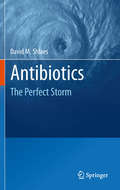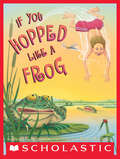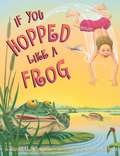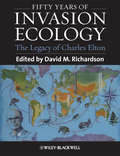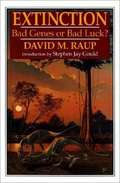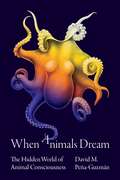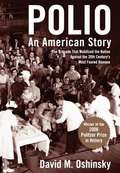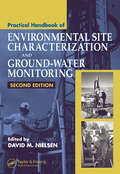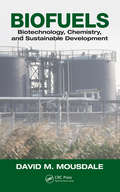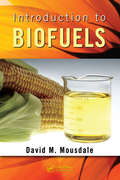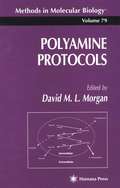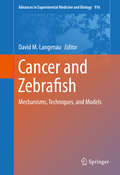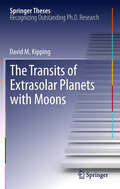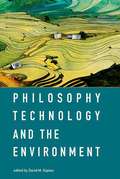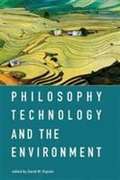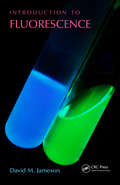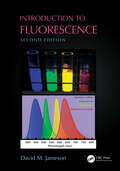- Table View
- List View
Reviews of Environmental Contamination and Toxicology: 202
by David M. WhitacreReviews of Environmental Contamination and Toxicology attempts to provide concise, critical reviews of timely advances, philosophy and significant areas of accomplished or needed endeavor in the total field of xenobiotics, in any segment of the environment, as well as toxicological implications.
Reviews of Environmental Contamination and Toxicology: 214
by David M. WhitacreReviews of Environmental Contamination and Toxicology attempts to provide concise, critical reviews of timely advances, philosophy and significant areas of accomplished or needed endeavor in the total field of xenobiotics, in any segment of the environment, as well as toxicological implications.
Reviews of Environmental Contamination and Toxicology: 215
by David M. WhitacreReviews of Environmental Contamination and Toxicology attempts to provide concise, critical reviews of timely advances, philosophy and significant areas of accomplished or needed endeavor in the total field of xenobiotics, in any segment of the environment, as well as toxicological implications.
Reviews of Environmental Contamination and Toxicology: 219
by David M. WhitacreReviews of Environmental Contamination and Toxicology attempts to provide concise, critical reviews of timely advances, philosophy and significant areas of accomplished or needed endeavor in the total field of xenobiotics, in any segment of the environment, as well as toxicological implications.
Reviews of Environmental Contamination and Toxicology: 220
by David M. WhitacreReviews of Environmental Contamination and Toxicology attempts to provide concise, critical reviews of timely advances, philosophy and significant areas of accomplished or needed endeavor in the total field of xenobiotics, in any segment of the environment, as well as toxicological implications.
Reviews of Environmental Contamination and Toxicology: 222
by David M. WhitacreReviews of Environmental Contamination and Toxicology attempts to provide concise, critical reviews of timely advances, philosophy and significant areas of accomplished or needed endeavor in the total field of xenobiotics, in any segment of the environment, as well as toxicological implications.
Reviews of Environmental Contamination and Toxicology: 229
by David M. WhitacreReviews of Environmental Contamination and Toxicology attempts to provide concise, critical reviews of timely advances, philosophy and significant areas of accomplished or needed endeavor in the total field of xenobiotics, in any segment of the environment, as well as toxicological implications.
Reviews of Environmental Contamination and Toxicology: 234
by David M. WhitacreReviews of Environmental Contamination and Toxicology attempts to provide concise, critical reviews of timely advances, philosophy and significant areas of accomplished or needed endeavor in the total field of xenobiotics, in any segment of the environment, as well as toxicological implications.
Antibiotics: The Perfect Storm
by David M. ShlaesAntibiotics are truly miracle drugs. As a class, they are one of the only ones that actually cure disease as opposed to most drugs that only help relieve symptoms or control disease. Since bacteria that cause serious disease in humans are becoming more and more resistant to the antibiotics we have today, and because they will ultimately become resistant to any antibiotic that we use for treatment or for anything else, we need a steady supply of new antibiotics active against any resistant bacteria that arise. However, the antibiotics marketplace is no longer attractive for large pharmaceutical companies, the costs of development are skyrocketing because of ever more stringent requirements by the regulatory agencies, and finding new antibiotics active against resistant strains is getting harder and harder. These forces are all combining to deny us these miracle drugs when we need them the most. I provide a number of possible paths to shelter from this perfect storm.
If You Hopped Like A Frog (If You... Ser.)
by David M. SchwartzHow far could you hop?If you hopped like a frog...you could jump from home plate to first base in one mighty leap!Did you know that a frog can jump 20 times its body length? Or that an ant can lift an object 50 times its own weight?Read this book and find out what you could do -- if you had the amazing abilities of animals! And there are endless possibilities for making more hilarious comparisons of your own. Get ready for ratio and proportion like you've never seen them before!
If You Hopped like a Frog
by David M. SchwartzDid you know that a frog can jump 29 times its body length? Or that an ant can lift an object 50 times its weight?
Fifty Years of Invasion Ecology: The Legacy of Charles Elton
by David M. RichardsonInvasion ecology is the study of the causes and consequences of the introduction of organisms to areas outside their native range. Interest in this field has exploded in the past few decades. Explaining why and how organisms are moved around the world, how and why some become established and invade, and how best to manage invasive species in the face of global change are all crucial issues that interest biogeographers, ecologists and environmental managers in all parts of the world. This book brings together the insights of more than 50 authors to examine the origins, foundations, current dimensions and potential trajectories of invasion ecology. It revisits key tenets of the foundations of invasion ecology, including contributions of pioneering naturalists of the 19th century, including Charles Darwin and British ecologist Charles Elton, whose 1958 monograph on invasive species is widely acknowledged as having focussed scientific attention on biological invasions.
Extinction: Bad Genes or Bad Luck?
by David M. RaupPresents a comprehensive overview of the current state of extinction studies.
When Animals Dream: The Hidden World of Animal Consciousness
by David M. Peña-GuzmánA spellbinding look at the philosophical and moral implications of animal dreamingAre humans the only dreamers on Earth? What goes on in the minds of animals when they sleep? When Animals Dream brings together behavioral and neuroscientific research on animal sleep with philosophical theories of dreaming. It shows that dreams provide an invaluable window into the cognitive and emotional lives of nonhuman animals, giving us access to a seemingly inaccessible realm of animal experience.David Peña-Guzmán uncovers evidence of animal dreaming throughout the scientific literature, suggesting that many animals run “reality simulations” while asleep, with a dream-ego moving through a dynamic and coherent dreamscape. He builds a convincing case for animals as conscious beings and examines the thorny scientific, philosophical, and ethical questions it raises. Once we accept that animals dream, we incur a host of moral obligations and have no choice but to rethink our views about who animals are and the interior lives they lead.A mesmerizing journey into the otherworldly domain of nonhuman consciousness, When Animals Dream carries profound implications for contemporary debates about animal cognition, animal ethics, and animal rights, challenging us to regard animals as beings who matter, and for whom things matter.
Polio: An American Story
by David M. OshinskyAll who lived in the early 1950s remember the fear of polio and the elation felt when a successful vaccine was found. Now David Oshinsky tells the gripping story of the polio terror and of the intense effort to find a cure, from the March of Dimes to the discovery of the Salk and Sabin vaccines - and beyond. Here is a remarkable portrait of America in the early 1950s, using the widespread panic over polio to shed light on our national obsessions and fears. Drawing on newly available papers of Jonas Salk, Albert Sabin and other key players, Oshinsky paints a suspenseful portrait of the race for the cure, weaving a dramatic tale centered on the furious rivalry between Salk and Sabin. Indeed, the competition was marked by a deep-seated ill will among the researchers that remained with them until their deaths. The author also tells the story of Isabel Morgan, perhaps the most talented of all polio researchers, who might have beaten Salk to the prize if she had not retired to raise a family. As backdrop to this feverish research, Oshinsky offers an insightful look at the National Foundation for Infantile Paralysis, which was founded in the 1930s by FDR and Basil O'Connor. The National Foundation revolutionized fundraising and the perception of disease in America, using "poster children" and the famous March of Dimes to raise hundreds of millions of dollars from a vast army of contributors (instead of a few well-heeled benefactors), creating the largest researchand rehabilitation network in the history of medicine. The polio experience also revolutionized the way in which the government licensed and tested new drugs before allowing them on the market, and the way in which the legal system dealt with manufacturers' liability for unsafe products. Finally, and perhaps most tellingly, Oshinsky reveals that polio was never the raging epidemic portrayed by the media, but in truth a relatively uncommon disease. But in baby-booming America - increasingly suburban, family-oriented, and hygiene-obsessed - the specter of polio, like the specter of the atomic bomb, soon became a cloud of terror over daily life. Both a gripping scientific suspense story and a provocative social and cultural history, Polio opens a fresh window onto postwar America.<P><P> Pulitzer Prize Winner
Practical Handbook of Environmental Site Characterization and Ground-Water Monitoring
by David M. NielsenPublished in 1991, the first edition of The Practical Handbook of Ground-Water Monitoring quickly became the gold standard reference on the topic of ground-water monitoring. But, as in all rapidly evolving fields, regulations change, technology advances, methods improve, and research reveals flaws in prior thinking. As a consequence, books t
Biofuels: Biotechnology, Chemistry, and Sustainable Development
by David M. MousdaleEvaluating a wealth of quantitative data, Biofuels: Biotechnology, Chemistry, and Sustainable Development discusses different types of biofuels, the science behind their production, the economics of their introduction to the marketplace, their environmental impacts, and their implications for world agriculture. It broadens the discussion on biofuel
Introduction to Biofuels (Mechanical and Aerospace Engineering Series)
by David M. MousdaleWhat role will biofuels play in the scientific portfolio that might bring energy independence and security, revitalize rural infrastructures, and wean us off of our addiction to oil? The shifting energy landscape of the 21st century, with its increased demand for renewable energy technology, poses a worrying challenge. Discussing the multidisciplin
Polyamine Protocols
by David M. MorganA unique collection of hands-on enzyme assay techniques to study polyamines and their function. The techniques range from assay methods for enzymes of polyamine biosynthesis and catabolism to measurements of polyamines, polyamine transport, and polyamine effects on cell growth. The methods are presented by leading researchers who have perfected them to a high art, and include clear, step-by-step instructions with numerous hints and tips to ensure readily reproducible results.
Cancer and Zebrafish: Mechanisms, Techniques, and Models (Advances in Experimental Medicine and Biology #916)
by David M. LangenauThis volume focuses on defining the unique attributes of using the zebrafish cancer model for discovering important pathways and potential drug targets for the treatment of human cancers. Using the zebrafish model, the volume explores oncogene and tumor suppressor discovery, chemical genetic approaches, genomics, epigenetics, cancer imaging, and cell transplantation. Contributed chapters come from the most prominent laboratories working in this field, which provides a unique perspective on zebrafish models from a wide spectrum of the research community. In addition, the book offers a detailed analysis of the most current research in the area for specific zebrafish cancer models, including T cell leukemia, rhabdomyosarcoma, liver and pancreatic cancer, melanoma, neuroblastoma, germ cell tumors, and malignant peripheral sheath tumors. A chapter is also dedicated to the development and utilization of other piscine models of cancer. The compilation of chapters in the volume culminates into a comprehensive and definitive text on zebrafish and cancer, providing a much needed resource on the powerful attributes of the zebrafish model system.
The Transits of Extrasolar Planets with Moons
by David M. KippingCan we detect the moons of extrasolar planets? For two decades, astronomers have made enormous progress in the detection and characterisation of exoplanetary systems but the identification of an "exomoon" is notably absent. In this thesis, David Kipping shows how transiting planets may be used to infer the presence of exomoons through deviations in the time and duration of the planetary eclipses. A detailed account of the transit model, potential distortions, and timing techniques is covered before the analytic forms for the timing variations are derived. It is shown that habitable-zone exomoons above 0.2 Earth-masses are detectable with the Kepler space telescope using these new timing techniques.
Philosophy, Technology, and the Environment
by David M. KaplanEnvironmental philosophy and philosophy of technology have taken divergent paths despite their common interest in examining human modification of the natural world. Yet philosophers from each field have a lot to contribute to the other. Environmental issues inevitably involve technologies, and technologies inevitably have environmental impacts. In this book, prominent scholars from both fields illuminate the intersections of environmental philosophy and philosophy of technology, offering the beginnings of a rich new hybrid discourse. All the contributors share the intuition that technology and the environment overlap in ways that are relevant in both philosophical and practical terms. They consider such issues as the limits of technological interventions in the natural world, whether a concern for the environment can be designed into things, how consumerism relates us to artifacts and environments, and how food and animal agriculture raise questions about both culture and nature. They discuss, among other topics, the pessimism and dystopianism shared by environmentalists, environmental philosophers, and philosophers of technology; the ethics of geoengineering and climate change; the biological analogy at the heart of industrial ecology; green products and sustainable design; and agriculture as a bridge between technology and the environment.ContributorsBraden Allenby, Raymond Anthony, Philip Brey, J. Baird Callicott, Brett Clark, Wyatt Galusky, Ryan Gunderson, Benjamin Hale, Clare Heyward,Don Idhe, Mark Sagoff, Julian Savulescu, Paul B. Thompson, Ibo van de Poel, Zhang Wei,Kyle Powys Whyte
Philosophy, Technology, and the Environment
by David M. KaplanEnvironmental philosophy and philosophy of technology have taken divergent paths despite their common interest in examining human modification of the natural world. Yet philosophers from each field have a lot to contribute to the other. Environmental issues inevitably involve technologies, and technologies inevitably have environmental impacts. In this book, prominent scholars from both fields illuminate the intersections of environmental philosophy and philosophy of technology, offering the beginnings of a rich new hybrid discourse. All the contributors share the intuition that technology and the environment overlap in ways that are relevant in both philosophical and practical terms. They consider such issues as the limits of technological interventions in the natural world, whether a concern for the environment can be designed into things, how consumerism relates us to artifacts and environments, and how food and animal agriculture raise questions about both culture and nature. They discuss, among other topics, the pessimism and dystopianism shared by environmentalists, environmental philosophers, and philosophers of technology; the ethics of geoengineering and climate change; the biological analogy at the heart of industrial ecology; green products and sustainable design; and agriculture as a bridge between technology and the environment.ContributorsBraden Allenby, Raymond Anthony, Philip Brey, J. Baird Callicott, Brett Clark, Wyatt Galusky, Ryan Gunderson, Benjamin Hale, Clare Heyward,Don Idhe, Mark Sagoff, Julian Savulescu, Paul B. Thompson, Ibo van de Poel, Zhang Wei,Kyle Powys Whyte
Introduction to Fluorescence
by David M. JamesonIn color throughout, this text helps readers acquire a sound understanding of basic fluorescence theory and practice. It takes them through the history of important discoveries to the most current advances. The author introduces the fundamentals of the fluorescence phenomenon and gives detailed examples of fluorescence applications in the molecular life sciences, including biochemistry, biophysics, clinical chemistry and diagnostics, pharmaceutical science, and cell and molecular biology. The text includes references in each chapter, more than 250 figures, and the chemical structures of the most widely used fluorescent molecules.
Introduction to Fluorescence
by David M. JamesonThe phenomenon known as ‘fluorescence’ is now widely used in the chemical, physical and life sciences largely due to the development of highly sophisticated fluorescent probe chemistries and the commercial availability of these probes as well as the development of novel microscopy approaches. This Second Edition of Introduction to Fluorescence helps readers acquire a thorough understanding of basic fluorescence theory and practice. It describes the general principles in a direct way and uses examples from a variety of disciplines to demonstrate them. Since the First Edition, significant advances in the field have appeared. For example, phasors, both lifetime and spectral phasors, have become very popular, and so a new chapter dedicated to this topic has been added in this edition. Furthermore, significant advances have been made in fluorescence microscopy methods, including super-resolution and single-molecule techniques.In color throughout, the book takes readers through the history of important discoveries to the most current advances. It introduces the fundamentals of the fluorescence phenomenon and gives detailed examples of fluorescence applications in the molecular life sciences, including biochemistry, biophysics, clinical chemistry and diagnostics, pharmaceutical science, and cell and molecular biology. The author presents the basic theories underlying the applications and offers in-depth information on practical aspects.Numerous references are given in each chapter, along with a list of particularly important references at the end of each chapter. The text incorporates more than 340 figures that clearly illustrate the concepts and gives the chemical structures of the most widely used fluorescent molecules. In addition, Chapter 13, the Appendix, provides a "Rogue’s Gallery" of the most common errors and pitfalls to avoid.








